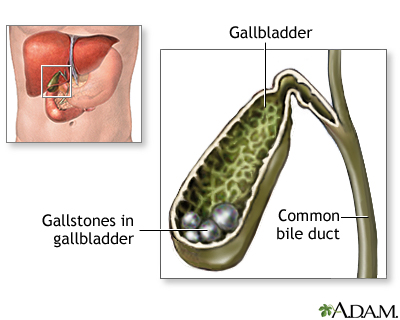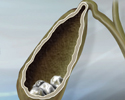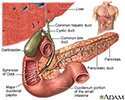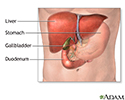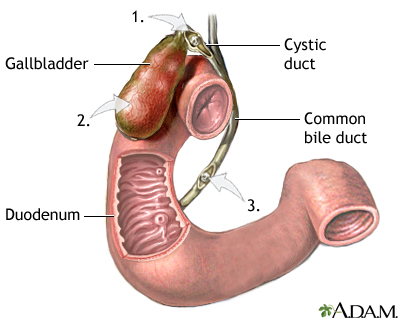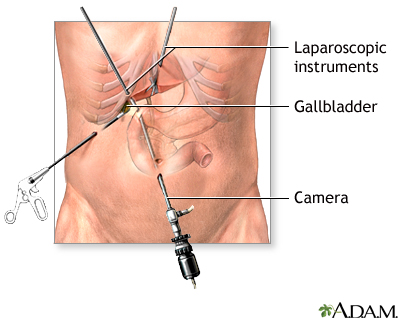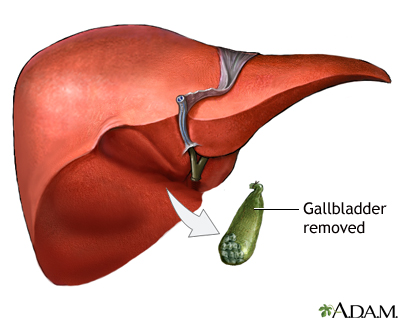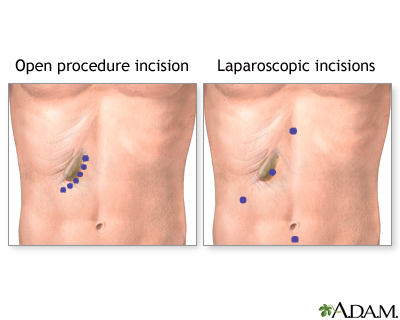Gallstones
Cholelithiasis; Gallbladder attack; Biliary colic; Gallstone attack; Biliary calculus: chenodeoxycholic acids (CDCA); Ursodeoxycholic acid (UDCA, ursodiol); Endoscopic retrograde cholangiopancreatography (ERCP)-gallstones
Gallstones are hard deposits that form inside the gallbladder. Gallstones may be as small as a grain of sand or as large as a golf ball.
Causes
The cause of gallstones varies. There are two main types of gallstones:
- Stones made of cholesterol. This is the most common type. Cholesterol gallstones are not related to cholesterol levels in the blood.
- Stones made of bilirubin. These are called pigment stones. They occur when red blood cells are destroyed and too much bilirubin is in the bile.
Gallstones are more common in women, Native Americans, Hispanics, people over age 40, and people who are overweight. Gallstones may also run in families.
The following factors also make you more likely to develop gallstones:
-
Bone marrow
or solid organ transplant
Bone marrow
A bone marrow transplant is a procedure to replace damaged or destroyed bone marrow with healthy bone marrow stem cells. Bone marrow is the soft, fat...
 ImageRead Article Now Book Mark Article
ImageRead Article Now Book Mark Article -
Diabetes
Diabetes
Diabetes is a chronic disease in which the body cannot regulate the amount of sugar in the blood.
 ImageRead Article Now Book Mark Article
ImageRead Article Now Book Mark Article - Failure of the gallbladder to empty bile properly (this is more likely to happen during pregnancy)
-
Liver cirrhosis
and biliary tract infections (pigmented stones)
Liver cirrhosis
Cirrhosis is scarring of the liver and poor liver function. It is the last stage of chronic liver disease.
 ImageRead Article Now Book Mark Article
ImageRead Article Now Book Mark Article -
Medical conditions that cause too many
red blood cells to be destroyed
Red blood cells to be destroyed
Anemia is a condition in which the body does not have enough healthy red blood cells. Red blood cells provide oxygen to body tissues. Normally, red ...
 ImageRead Article Now Book Mark Article
ImageRead Article Now Book Mark Article - Rapid weight loss from eating a very low-calorie diet, or after weight loss surgery
- Receiving nutrition through a vein for a long period of time (intravenous feedings)
- Taking birth control pills
Symptoms
Many people with gallstones do not have any symptoms. The gallstones are often found during a routine x-ray, abdominal surgery, or other medical procedure.
However, if a large stone blocks a tube or duct that drains the gallbladder, you may have a cramping pain in the middle to right upper abdomen. This is known as biliary colic. The pain goes away if the stone passes into the first part of the small intestine.
Stone blocks a tube
Choledocholithiasis is the presence of at least one gallstone in the common bile duct. The stone may be made up of bile pigments or calcium and chol...

Symptoms that may occur include:
- Pain in the right upper or middle upper abdomen for at least 30 minutes. The pain may be constant or cramping. It can feel sharp or dull.
- Fever
- Yellowing of skin and whites of the eyes (jaundice)
Other symptoms may include:
- Clay-colored stools
- Nausea and vomiting
Exams and Tests
Tests used to detect gallstones or gallbladder inflammation include:
-
Ultrasound, abdomen
Ultrasound, abdomen
Abdominal ultrasound is a type of imaging test. It is used to look at organs in the abdomen, including the liver, gallbladder, spleen, pancreas, and...
 ImageRead Article Now Book Mark Article
ImageRead Article Now Book Mark Article -
CT scan, abdomen
CT scan, abdomen
An abdominal CT scan is an imaging method. This test uses x-rays to create cross-sectional pictures of the belly area. CT stands for computed tomog...
 ImageRead Article Now Book Mark Article
ImageRead Article Now Book Mark Article - Endoscopic retrograde cholangiopancreatography (ERCP)
-
Gallbladder radionuclide scan
Gallbladder radionuclide scan
Gallbladder radionuclide scan is a test that uses radioactive material to check gallbladder function. It is also used to look for bile duct blockage...
 ImageRead Article Now Book Mark Article
ImageRead Article Now Book Mark Article - Endoscopic ultrasound
- Magnetic resonance cholangiopancreatography (MRCP)
-
Percutaneous transhepatic cholangiogram
(PTCA)
Percutaneous transhepatic cholangiogram
A percutaneous transhepatic cholangiogram (PTCA) is an x-ray of the bile ducts. These are the tubes that carry bile from the liver to the gallbladde...
 ImageRead Article Now Book Mark Article
ImageRead Article Now Book Mark Article
Your doctor may order the following blood tests:
-
Bilirubin
Bilirubin
The bilirubin blood test measures the level of bilirubin in the blood. Bilirubin is a yellowish pigment found in bile, a fluid made by the liver. Bi...
 ImageRead Article Now Book Mark Article
ImageRead Article Now Book Mark Article -
Liver function tests
Liver function tests
Liver function tests are common tests that are used to see how well the liver is working. Tests include:AlbuminAlpha-1 antitrypsin Alkaline phosph...
 ImageRead Article Now Book Mark Article
ImageRead Article Now Book Mark Article - Pancreatic enzymes
Treatment
SURGERY
Most of the time, surgery is not needed unless symptoms begin. However, people planning weight loss surgery may need to have gallstones removed before undergoing the procedure. In general, people who have symptoms will need surgery right away or soon after the stone is found.
-
A technique called
laparoscopic cholecystectomy
is most commonly used. This procedure uses small surgical cuts, which allow for a faster recovery. A person can often go home from the hospital within 1 day of surgery.
Laparoscopic cholecystectomy
Laparoscopic gallbladder removal is surgery to remove the gallbladder using a medical device called a laparoscope.
 ImageRead Article Now Book Mark Article
ImageRead Article Now Book Mark Article -
In the past, open
cholecystectomy
(gallbladder removal) was most often done. However, this technique is less common now.
Cholecystectomy
Open gallbladder removal is surgery to remove the gallbladder through a large cut in your abdomen.
 ImageRead Article Now Book Mark Article
ImageRead Article Now Book Mark Article
Endoscopic retrograde cholangiopancreatography (ERCP) and a procedure called a sphincterotomy may be done to find or treat gallstones in the common bile duct .
Gallstones in the common bile duct
Choledocholithiasis is the presence of at least one gallstone in the common bile duct. The stone may be made up of bile pigments or calcium and chol...

MEDICINES
Medicines may be given in pill form to dissolve cholesterol gallstones. However, these drugs may take 2 years or longer to work, and the stones may return after treatment ends.
Rarely, chemicals are passed into the gallbladder through a catheter. The chemical rapidly dissolves cholesterol stones. This treatment is hard to perform, so it is not done very often. The chemicals used can be toxic, and the gallstones may return.
LITHOTRIPSY
Shock wave lithotripsy (ESWL) of the gallbladder has also been used for people who cannot have surgery. This treatment is not used as often as it once was because gallstones often come back.
Outlook (Prognosis)
You may need to be on a liquid diet or take other steps to give your gallbladder a rest after you are treated. Your health care provider will give you instructions when you leave the hospital.
Liquid diet
Chronic cholecystitis - discharge; Dysfunctional gallbladder - discharge; Choledocholithiasis - discharge; Cholelithiasis - discharge; Acute cholecys...

The chance of symptoms or complications from gallstones is low. Nearly all people who have gallbladder surgery do not have their symptoms return.
Possible Complications
Blockage by gallstones may cause swelling or infection in the:
- Gallbladder (cholecystitis)
-
Tube that carries bile from the liver to the gallbladder and intestines (
cholangitis
)
Cholangitis
Cholangitis is an infection of the bile ducts, the tubes that carry bile from the liver to the gallbladder and intestines. Bile is a liquid made by ...
 ImageRead Article Now Book Mark Article
ImageRead Article Now Book Mark Article - Pancreas (pancreatitis)
When to Contact a Medical Professional
Call your provider if you have:
- Pain in the upper part of your abdomen
- Yellowing of the skin or whites of the eyes
Prevention
In most people, gallstones can't be prevented. In people who are obese, avoiding rapid weight loss may help prevent gallstones.
References
Fogel EL, Sherman S. Diseases of the gallbladder and bile ducts. In: Goldman L, Schafer AI, eds. Goldman's Cecil Medicine . 25th ed. Philadelphia, PA: Elsevier Saunders; 2016:chap 155.
Jackson PG, Evans SRT. Biliary system. In: Townsend CM Jr, Beauchamp RD, Evers BM, Mattox KL, eds. Sabiston Textbook of Surgery . 19th ed. Philadelphia, PA: Elsevier Saunders; 2012:chap 55.
-
Gallstones
Animation
-
Digestive system - illustration
The esophagus, stomach, large and small intestine, aided by the liver, gallbladder and pancreas convert the nutritive components of food into energy and break down the non-nutritive components into waste to be excreted.
Digestive system
illustration
-
Kidney cyst with gallstones, CT scan - illustration
A CT scan of the upper abdomen showing a fist-sized cyst of the left kidney and gallstones (the kidney cyst was found by chance; there were no symptoms).
Kidney cyst with gallstones, CT scan
illustration
-
Gallstones, cholangiogram - illustration
A cholecystogram in a patient with gallstones.
Gallstones, cholangiogram
illustration
-
Cholecystolithiasis - illustration
Cholecystolithiasis. CT scan of the upper abdomen showing multiple gallstones.
Cholecystolithiasis
illustration
-
Cholelithiasis - illustration
Normally a balance of bile salts, lecithin and cholesterol keep gallstones from forming. If there are abnormally high levels of bile salts or, more commonly, cholesterol, stones can form. Symptoms usually occur when the stones block one of the biliary ducts or gallstones may be discovered upon routine x-ray or abdominal CT study.
Cholelithiasis
illustration
-
Gallbladder - illustration
The gallbladder is a muscular sac located under the liver. It stores and concentrates the bile produced in the liver that is not immediately needed for digestion. Bile is released from the gallbladder into the small intestine in response to food. The pancreatic duct joins the common bile duct at the small intestine adding enzymes to aid in digestion.
Gallbladder
illustration
-
Gallbladder removal - Series
Presentation
-
Digestive system - illustration
The esophagus, stomach, large and small intestine, aided by the liver, gallbladder and pancreas convert the nutritive components of food into energy and break down the non-nutritive components into waste to be excreted.
Digestive system
illustration
-
Kidney cyst with gallstones, CT scan - illustration
A CT scan of the upper abdomen showing a fist-sized cyst of the left kidney and gallstones (the kidney cyst was found by chance; there were no symptoms).
Kidney cyst with gallstones, CT scan
illustration
-
Gallstones, cholangiogram - illustration
A cholecystogram in a patient with gallstones.
Gallstones, cholangiogram
illustration
-
Cholecystolithiasis - illustration
Cholecystolithiasis. CT scan of the upper abdomen showing multiple gallstones.
Cholecystolithiasis
illustration
-
Cholelithiasis - illustration
Normally a balance of bile salts, lecithin and cholesterol keep gallstones from forming. If there are abnormally high levels of bile salts or, more commonly, cholesterol, stones can form. Symptoms usually occur when the stones block one of the biliary ducts or gallstones may be discovered upon routine x-ray or abdominal CT study.
Cholelithiasis
illustration
-
Gallbladder - illustration
The gallbladder is a muscular sac located under the liver. It stores and concentrates the bile produced in the liver that is not immediately needed for digestion. Bile is released from the gallbladder into the small intestine in response to food. The pancreatic duct joins the common bile duct at the small intestine adding enzymes to aid in digestion.
Gallbladder
illustration
-
Gallbladder removal - Series
Presentation
-
Gallstones and gallbladder disease
(In-Depth)
Review Date: 4/20/2015
Reviewed By: Subodh K. Lal, MD, gastroenterologist at Gastrointestinal Specialists of Georgia, Austell, GA. Review provided by VeriMed Healthcare Network. Also reviewed by David Zieve, MD, MHA, Isla Ogilvie, PhD, and the A.D.A.M. Editorial team.

